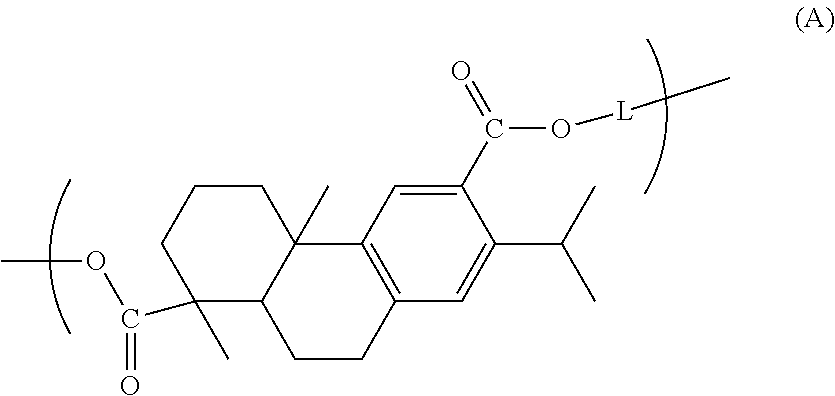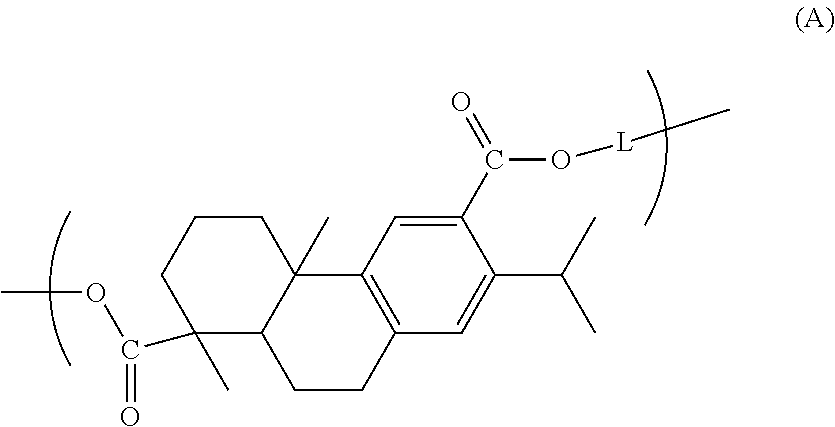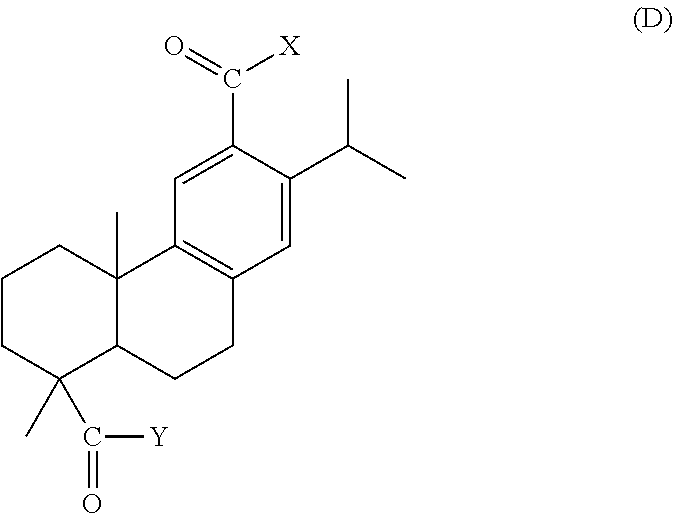Dehydroabietic acid polymer, compact, method for producing dehydroabietic acid polymer, and dehydroabietic acid compound
a dehydroabietic acid polymer and compact technology, applied in the preparation of carboxylic acid esters, chemistry apparatus and processes, organic chemistry, etc., can solve the problems of poor impact resistance, heat resistance, hydrolysis resistance, and low transparency of polylactic acids, and achieve high impact resistance, and high resistance to moisture and water.
- Summary
- Abstract
- Description
- Claims
- Application Information
AI Technical Summary
Benefits of technology
Problems solved by technology
Method used
Image
Examples
example 1
[0111](Synthesis of Dehydroabietic Acid Polymer (1))
[0112]10.0 g of the compound (1e) and 50 mg of tetraethyl orthotitanate were placed in a 50-ml three-necked flask equipped with a nitrogen inlet tube, stirred while nitrogen was gently blown into the flask, the temperature was elevated to 230° C., and the mixture was heated for 3 hours at 230° C. Subsequently, the mixture was allowed to react at 270° C. for 3 hours, under reduced pressure (133 Pa). After cooling, the reactant was dissolved in 50 ml of tetrahydrofuran, and insoluble matter was removed. Thereafter, the solution was poured into 1000 ml of methanol, and the precipitate was collected by filtration. The precipitate was washed with methanol, and dried to obtain 8.2 g of white powder, and used as the dehydroabietic acid polymer (1).
[0113]The weight average molecular weight of the dehydroabietic acid polymer (1) was 98,000 as measured by GPC. As a thermophysical property of the dehydroabietic acid polymer (1), the glass tra...
example 2
[0114](Synthesis of Dehydroabietic Acid Polymer (2))
[0115]10.5 g of the compound (2e) and 50 mg of tetraethyl orthotitanate were placed in a 50-ml three-necked flask equipped with a nitrogen inlet tube, stirred while nitrogen was gently blown into the flask, the temperature was elevated to 230° C., and the mixture was heated for 3 hours at 230° C. Subsequently, the mixture was allowed to react at 270° C. for 3 hours under reduced pressure (Hb). After cooling, the reactant was dissolved in 50 ml of tetrahydrofuran, and insoluble matter was removed. Thereafter, the solution was poured into 1000 ml of methanol, and the precipitate was collected by filtration. The precipitate was washed with methanol, and dried to obtain 8.4 g of white powder, and used as the dehydroabietic acid polymer (2).
[0116]The weight average molecular weight of the dehydroabietic acid polymer (1) was 79,000 as measured by GPC. As a thermophysical property of the dehydroabietic acid polymer (1), the glass transiti...
example 3
[0117](Synthesis of Dehydroabietic Acid Polymer (3))
[0118]9.2 g of the compound (1e), 5.65 g of the compound (3f), and 30 mg of antimony oxide were placed in a 50-ml three-necked flask equipped with a nitrogen inlet tube, and stirred under heating at 180° C. for 3 hours while nitrogen was gently blown into the flask. Subsequently, the mixture was heated at 230° C. for 2 hours, and then 270° C. for 2 hours, under reduced pressure. After cooling, 100 ml of tetrahydrofuran was added to the reactant and the reactant was dissolved under heating, and insoluble matter was removed by filtration. Thereafter, the solution was poured into 1000 ml of methanol, and the precipitate was collected by filtration. The precipitate was washed with methanol, and dried to obtain 11.6 g of white powder, and used as the dehydroabietic acid polymer (3).
[0119]The weight average molecular weight of the dehydroabietic acid polymer (3) was 128,000 as measured by GPC. As a thermophysical property of the dehydroa...
PUM
| Property | Measurement | Unit |
|---|---|---|
| temperature | aaaaa | aaaaa |
| temperature | aaaaa | aaaaa |
| temperature | aaaaa | aaaaa |
Abstract
Description
Claims
Application Information
 Login to View More
Login to View More - R&D
- Intellectual Property
- Life Sciences
- Materials
- Tech Scout
- Unparalleled Data Quality
- Higher Quality Content
- 60% Fewer Hallucinations
Browse by: Latest US Patents, China's latest patents, Technical Efficacy Thesaurus, Application Domain, Technology Topic, Popular Technical Reports.
© 2025 PatSnap. All rights reserved.Legal|Privacy policy|Modern Slavery Act Transparency Statement|Sitemap|About US| Contact US: help@patsnap.com



